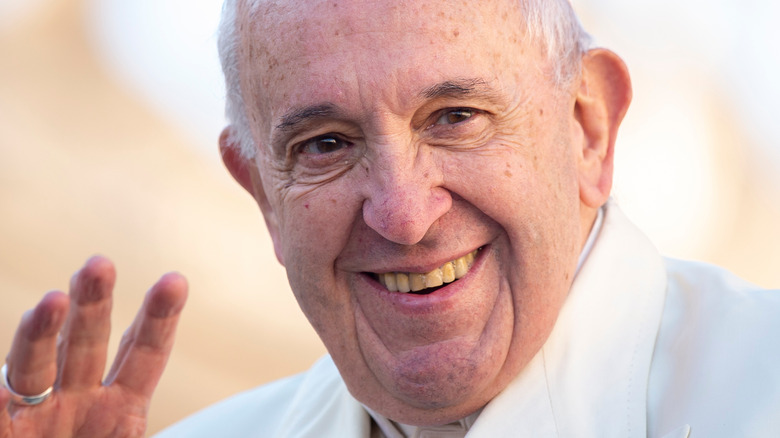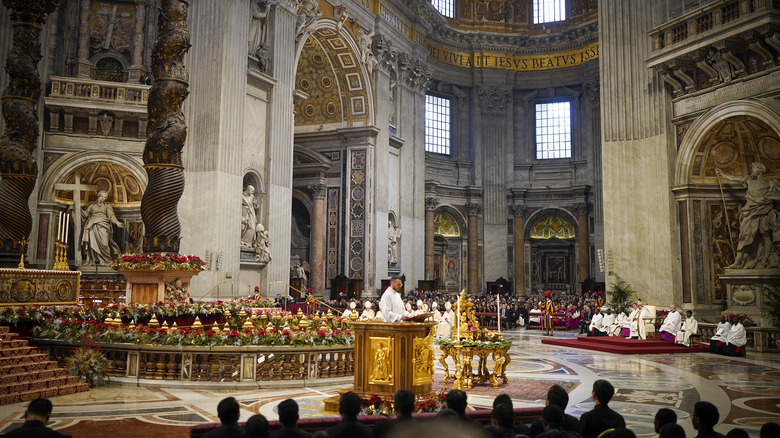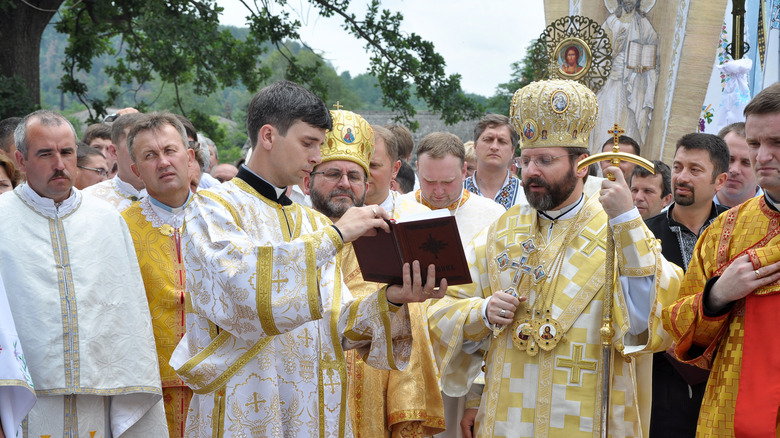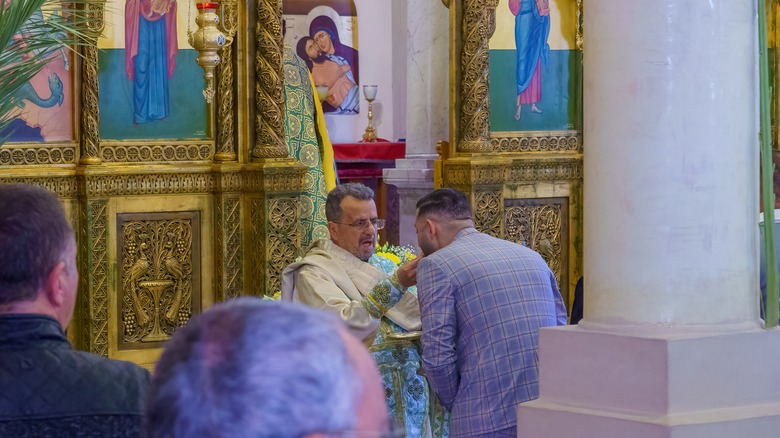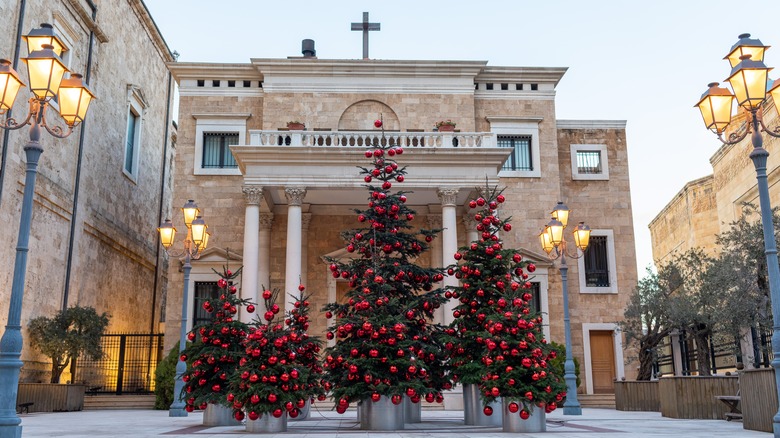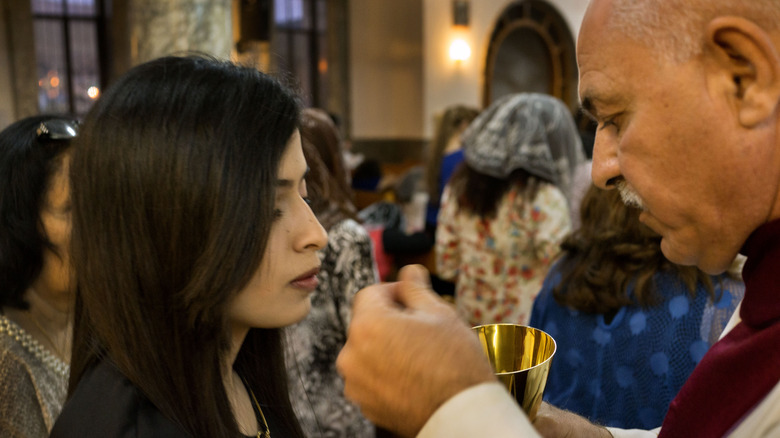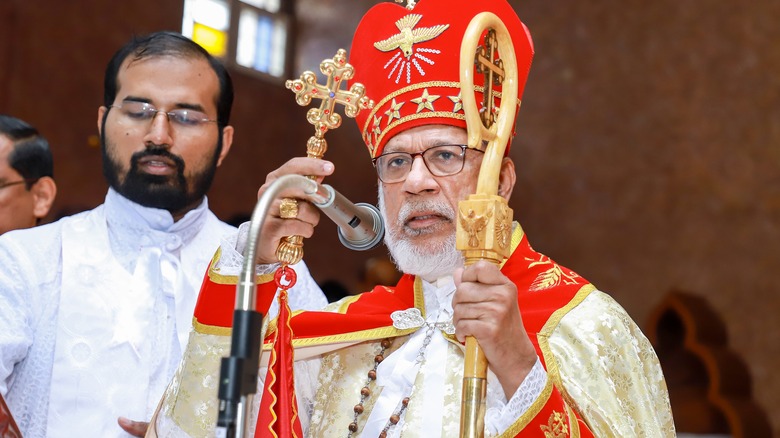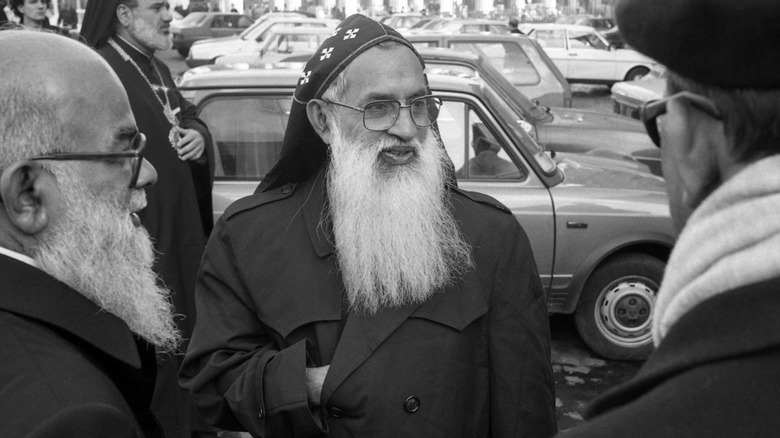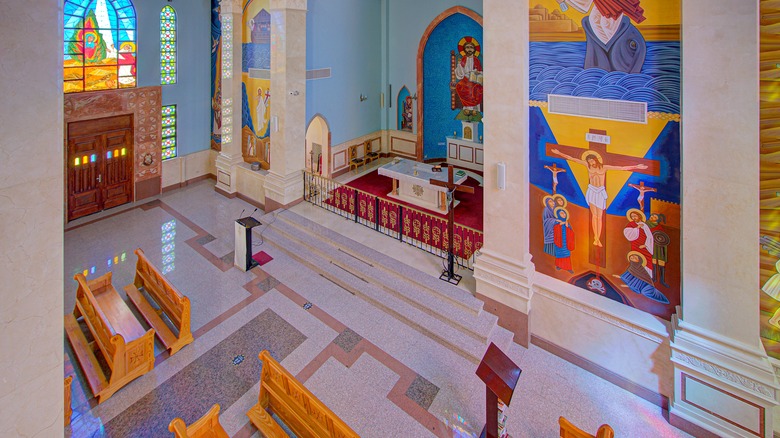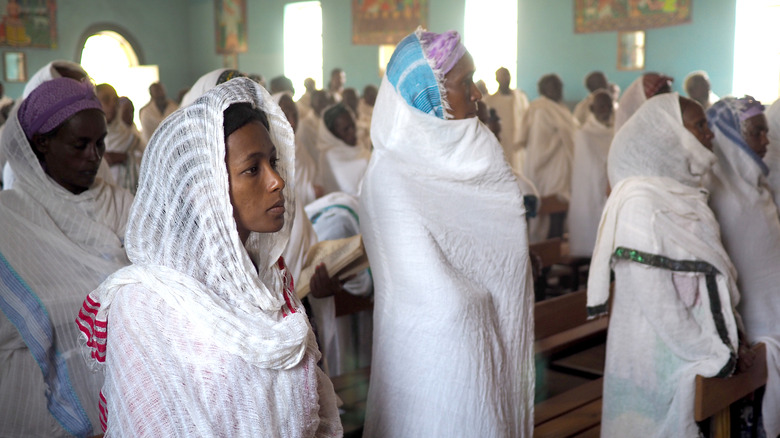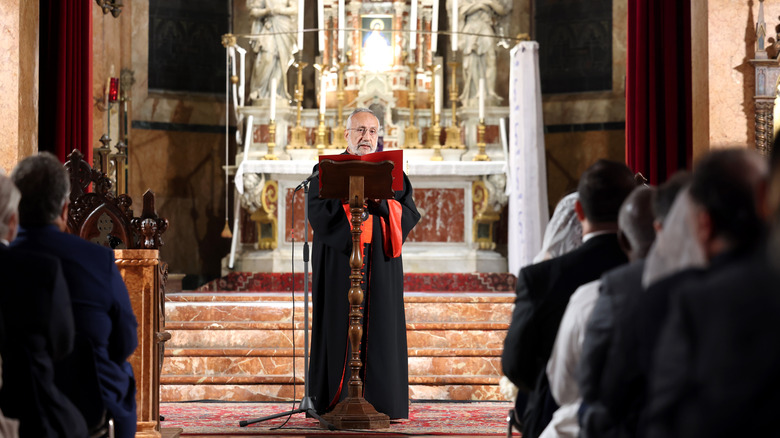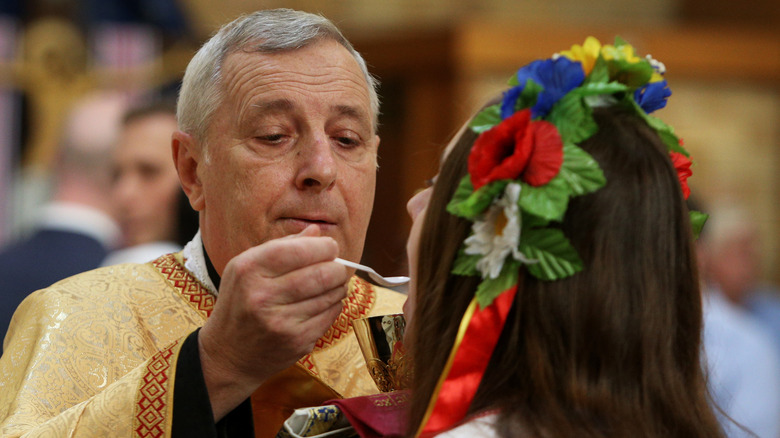The Different Catholic Churches Explained (And Why There Are 24 Of Them)
When one hears the phrase Catholic Church, the immediate association is with the Roman Catholic Church, the Vatican, the pope, and the city of Rome. But occasionally one sees a church that is labeled as "Maronite," "Ukrainian Catholic," or something similar. Due to the aesthetics or national associations, people might even assume they are simply mislabeled Orthodox churches.
However, they are Catholic just as much as the Roman Catholic Church and the pope are Catholic. This is because, in reality, the Catholic Church is one large umbrella organization consisting of 24 different churches — the Roman church and 23 other "sue iuris" churches. Per Ascension Press, these 23 others are churches that are governed separately in their own right but owe allegiance to Rome.
These churches all have their own traditions, history, culture, language, and reasons for existing. Many of them are former Orthodox churches that rejoined Rome, while others were simply separated by distance and time. Here are the 24 different Catholic churches explained.
The Roman Catholic Church
Generally considered synonymous with "Catholic" Roman Catholic/Latin Church (RCC) is the largest Catholic church, containing nearly 99% of Catholic believers according to EWTN. The RCC traces its ancestry to Jesus Christ himself and St. Peter, teaching that Christ founded the Catholic Church with Peter as "the Rock" upon which He would build His Church, per Aleteia. The leader of the RCC (and the Catholic Church as a whole) – the Pope – is the successor of St. Peter and thus the representative of Jesus Christ on earth.
The RCC's chief distinguishing feature is the use of Latin, as its name suggests. According to the Vatican's own website, the use of Latin developed chiefly because of Roman rule over Western Europe, where the Roman Catholic Church developed its core of adherents. As the most widely spoken language, it was the best vehicle for proselytism and liturgy,
The RCC has historically contained a series of sub-rites as well, as noted by EWTN, the most famous being the Ambrosian and Mozarabic rights, although the latter is confined today to the Italian region of Lombardy and the city of Milan while the former is rarely celebrated anymore. The old Latin mass is also rarely celebrated, replaced with the current Novus Ordo of the Second Vatican Council – a lightning rod for controversy in recent years.
The Greek Catholic Churches
Of the 24 different Catholic Churches, about 13 of them (depending on who is counting) fall under the title "Greek" per the Diocese of St. Petersburg. According to the Jesuit Catholics and Cultures, the name refers to the fact that the rite of these churches, often called "Byzantine," developed in Constantinople – the capital of the Greek-speaking Eastern Roman Empire. It has nothing to do with Greek ethnicity. Today, there are multiple Greek Catholic churches organized along national lines mostly in Eastern Europe, the largest of which is the Ukrainian Greek Catholic Church (UGCC).
The Greek Catholics are distinguished by one major feature: they are all former Orthodox Churches. Using the UGCC as an example, the church in Ukraine remained with Constantinople following the Great Schism of 1054. When Western Ukraine came under Polish rule, however, a handful of Orthodox bishops signed the Union of Brest, which placed them under papal authority but allowed them to keep their own catechism, the Orthodox Divine Liturgy, and all the use of their own liturgical languages.
Today, each Greek Catholic Church has its own leader, answerable to Pope Francis. The most famous is UGCC head Major Archbishop Sviatoslav Shevchuk. Some churches have more power and influence than others mostly based on size, with the UGCC and its Romanian counterpart at the top. Then there are the Ruthenian and Slovak churches, and nine other smaller ones scattered throughout Eastern Europe and the Balkans, per the Diocese of St. Petersburg.
The Melkite Greek Catholic Church
The Syrian Melkite Church is technically a Greek Catholic Church, according to the Encyclopedia of Ukraine, but has a different history from its Eastern European brethren. The Melkites trace their liturgical ancestry to the Syrian Christian community of Antioch, per St. John the Baptist Melkite Church. But then things get a bit messy. Syria was a diverse place. Antioch was primarily Greek-speaking, and the surrounding countryside spoke Aramaic, per the Melkite Eparchy of Newton. Both languages were used in Syrian churches. But in 451, the Council of Chalcedon split the Christian world, separating a number of Middle Eastern churches from Rome and Constantinople, per Britannica.
The Melkites, which literally means "the king's men," were Syrian Christians who accepted the Council of Chalcedon's theological conclusions and remained loyal to the Byzantine emperor and Constantinople, becoming a branch of the Orthodox Church, while the rest joined the Church of the East.
In the 16th and 17th centuries, the Melkites began to look to Rome. At that time, they were under Muslim Ottoman rule and forbidden from opening any schools. So the Roman Catholic Church opened up a series of schools to educate them in Italy. These Middle Eastern students not only found freedom in Rome but also were impressed with the beauty of the church's Renaissance and Baroque art. When they returned home to Syria, they brought back pro-Rome sympathies. When Seraphim Tanas was elected Patriarch of Antioch in 1724, he promptly united the Melkites with Rome, where they remain today as a distinct Arabic-speaking Greek church within the greater Catholic Church.
The Maronite Catholic Church
The Aramaic-speaking Lebanese Maronite Church traces its ancestry to Jesus Christ's visit to Tyre and Sidon, per St. Sharbel's Church. These pagan strongholds were not fully evangelized until one St. Maron came along to finish the job in the 4th century AD. While Syrian Christians mostly repudiated the 451 Council of Chalcedon, St. Maron's followers did not. They remained loyal to Rome, and were pejoratively dubbed "Maronites."
Living in the isolated mountains of Lebanon at a time when communication wasn't exactly instant, the Latin West forgot the Maronites until Latin crusaders encountered them, in the 12th century, per CNEWA. Upon contact, however, the Maronites eagerly signed an agreement of formal unity with Rome in 1182 and even sent Patriarch Jeremias II Al-Amshitti as a representative to the Fourth Lateran Council in 1215.
Today, Maronites are synonymous with Lebanon, which was founded as a Maronite oasis in the Middle East, forming the majority of Lebanon's population in 1932, per The Nation. Following the 1974 Civil War and mass Christian emigration, Maronites, and Christians in general, are less than 30% of the Lebanese population, per Aleteia, while Muslims have surged to over 40%. In fact, per Catholics and Cultures, most Maronites today live in the Lebanese diaspora scattered around the world.
As a result of centuries of Islamic rule, most Maronites speak Arabic, per the Church's Canadian website. Certain parts of the liturgy are still in Aramaic, while Arabic or another local language is used for the rest.
The Chaldean Catholic Church
The Chaldean Catholic Church per Catholics and Cultures traces its roots to the "Nestorian" Church of the East. The Church of the East severed contact with Rome in 431 AD and definitively in 451 AD, per the Anastasis Center. It opted instead for the patronage of the Sassanian Persian Empire and later, Muslim rule. Its missionaries preached across Iran, Central Asia, India, and China, and may even have possibly reached Japan before Buddhism did.
In 1552, the church fractured. Katholikos Shemon VII angered his clergy by appointing his teenage nephews to several important positions within the church, per "The Ecclesiastical Organization of the Church of the East." Outraged, a monk named Sulaqa petitioned the pope for union with Rome and in the ensuing confusion, got himself anointed Patriarch Simon VIII of Mosul, per CNEWA. This became the Chaldean Catholic Church.
The Chaldean Church has suffered among the most vicious persecutions, per Cardinal Louis Rafael Sako. World War I and the Armenian Genocide (which also targeted Assyrians) and ISIS persecution have emptied the Church's core in Iraq and Syria of many faithful. Cardinal Sako has proposed reuniting all Assyrian Christians to combat persecution: he and Mar Awa, the head of the non-Catholic Assyrian Church of the East, resign their positions and the clergy of both churches elects a new leader as head of the Church of the East under the pope, per La Stampa. Mar Awa has rejected this proposal in an interview, instead calling for a gradual reunification with Rome after other theological problems are resolved.
The Syro-Malabar Catholic Church
The Syro-Malabar Church of Western India traces its origins back to St. Thomas the Apostle and was originally part of the old Church of the East, per its own website. In 1498, these Christians came into contact with Portuguese explorers, who under the impression that these Indian Christians were heretics, forced Latinization upon them over the course of the 16th century. Following the death of the last Church of the East bishop in 1597, the 1599 Synod of Diamper officially brought the Syro-Malabar Christians under Portuguese Catholic rule.
Of course, there were problems. While the Syro-Malabar Christians chafed under Portuguese rule, whose justifications were more often more political and economic than religious. When some dissidents with Church of the East sympathies defied the Catholic Church by appointing their own bishop at an event called the Coonan Cross Oath, the papacy stepped in to correct the abuses. Rome yanked authority from the Portuguese and placed India under native Catholic bishops who knew their people and customs. The liturgy, however, had been so heavily Latinized that according to CNEWA, it was virtually indistinguishable from the Latin Rite at first glance.
Tensions between Latin and Syriac traditions have resulted in a series of "mass wars" among the faithful. According to Pillar Catholic, a riot broke out in one diocese over a dispute as to how much of the liturgy should be based on the Roman Rite and how much on the Syriac Rite. Today, the Syro-Malabar liturgy is a mix of both and counts faithful across India and in the diaspora.
The Syro-Malankara Catholic Church
The Syro-Malankara Catholic Church of Kerala is another descendant of St. Thomas' Indian evangelization efforts per its own website, and shares a common history with the Syro-Malabar Church. The two churches, however, diverged in 1653. Per the website of the Syro-Malabar Church, the group of dissidents who took the Coonan Cross Oath that year joined up with the Syriac Orthodox Church of Antioch. This became the Syro-Malankara Orthodox Church, which existed separately from the Syro-Malabar Catholics who continued under papal authority.
This arrangement prevailed until 1926, when four bishops, led by one Mar Ivanios, unhappy about being under the rule of Syrian patriarchs, approached Rome and asked to join the Catholic Church. They requested to keep their bishops and associated territories and their liturgy (known as "the Holy Qurubo"). In return, they had to make the Catholic Church's profession of faith and swear loyalty to the pope – and that was it.
The union went through, and today there are nearly 500,000 Syro-Malankara faithful, mostly in India, although there are diaspora communities, especially in the U.K. and the United States. It retains its own hierarchy and seminaries, while its head, Katholikos Moran Mor Baselios Cleemis, is a major archbishop, cardinal, and papal elector.
The Coptic Catholic Church
The Coptic Church of Alexandria in Egypt arose from the schism over theological disagreements following the 451 Council of Chalcedon. According to the Church of St. Mark and St. George, Copts argue that their position was deliberately distorted for political purposes. Regardless, the Alexandrian Church became independent with Coptic (a descendant of Ancient Egyptian) as its liturgical language.
Despite the split, the Catholic Church never forgot about the Copts, who eventually came under Muslim rule. A 1442 attempt at unity failed due to a lack of support in Egypt, per CNEWA, as did later dialogue between Coptic priests and Catholic missionaries. In 1700, their union seemed impossible.
Instead, the Coptic Catholic Church was born semi-accidentally. In 1741, a Coptic bishop named Anba Athanasius converted to Catholicism and was appointed "Vicar Apostolic" for approximately 2,000 Egyptian Catholics – most of whom were not in Egypt but in Jerusalem. Funnily enough, Anba returned to the Coptic Orthodox Church, so the enterprise didn't really go anywhere until 1824, when the papacy officially created a Coptic Catholic Church as a sui iuris body – except that it only existed on paper and no one actually asked for it.
Only in 1899, did the church receive a leader – Patriarch Cyril II Makarios. But he was then forced to resign over a scandal in 1908, leaving the patriarchate empty until 1947. Unsurprisingly, this slow start has meant that the Coptic Catholic Church remains a tiny minority with 162,000 adherents, dwarfed by its Orthodox counterpart of 15 million in Egypt alone.
The Ethiopian and Eritrean Catholic Churches
Christianity has been present in Ethiopia since the times of the Apostles and the Kingdom of Axum was among the very first to embrace Christianity, according to Dr. Vince Bantu of the Jude 3 Project. But historically, Ethiopia looked to Alexandria rather than Rome or Constantinople, and has been separate since 451. Despite the split, problems with Muslim neighbors led Ethiopia to ally with Catholic Portugal against neighboring Muslim Adal and the Ottoman Empire, which were attempting to conquer Ethiopia, per Prof. Jeffery Shaw (via Salve Regina University). Ethiopia won a decisive – albeit costly – victory thanks to Portuguese gunpowder.
The Ethiopian-Adal War was a catalyst for an attempted union, per Ascension Press, but it failed. Instead, it fell to Italian missionaries in the 19th century to create an Ethiopian Catholic Church. But the Italians, under Giustino de Jacobis, had learned from previous failures. Instead of forcing Latinization, they conducted their work according to the Coptic/Alexandrian Rite, celebrating their liturgies in accordance with local tradition.
The Ethiopian Catholic Church has its own head, Cardinal Berhaneyesus Demerew Souraphie, and like its Ethiopian Orthodox counterpart, uses the ancient Ge'ez language in its liturgies instead of Latin. It follows the Coptic calendar, and includes some interesting customs, such as the use of drums during services and yelling by women before communion – considered an act of joy. As seen above, men and women are also segregated.
In 2015, due to political tensions arising from the war between Eritrea and Ethiopia, Pope Francis separated the Eritrean part of the church into a separate body. But aside from leadership, the churches are identical.
The Armenian Catholic Church
Armenia holds the title of being the first country ever to convert to Christianity under King Tiridates III in 301 AD, per the Armenian Apostolic Church. However, theological disagreements led the church to follow the Coptic Church into schism following the 451 Council of Chalcedon, per the Vatican website. The split did not stop Rome from attempting reunification, however, during the Crusades and later during the Renaissance and Baroque periods, per Catholics and Cultures. Missionaries had moderate success, establishing a Catholic diocese in Nakhchivan (today in Azerbaijan) around 1400 with some local converts.
Catholicism soon butted heads with the Armenian Apostolic Church, which considered itself the only Armenian religious institution under the slogan of "one Church for the entire nation." In fact, because of the hostility, the Armenian Catholic Church (ACC) was not created in Armenia, but among the diaspora in Lebanon in 1742.
During the 1915 Armenian Genocide, the ACC lost every single parish within the Ottoman Empire outside Istanbul along with almost all of its priests and a large portion of its faithful. Among them is Ignatius Maolyan, who according to the Vatican was martyred after refusing to convert to Islam. After the genocide, Armenia fell under the Soviets, who closed the remaining Catholic churches and killed or exiled surviving clergy. Only a few churches among Armenians in Georgia survived.
Today, there are efforts to revitalize the church, but it suffers from a lack of clergy and migration of its faithful to large cities where Orthodoxy and the Armenian Apostolic Church reign supreme.
How these differences work in practice
While all of these churches operate on their own bases and have separate leadership, they all form one united body under the authority of the pope in Rome. What does this mean in practice? According to EWTN, when it comes to everyday matters such as attending each other's churches, it doesn't change much. Any Catholic of any rite may receive communion in any church of any other rite as long as he is properly disposed to do so.
The differences come mainly in other sacraments and celebrations of certain holidays. For instance, the Ukrainian Greek Catholic Church has traditionally celebrated Christmas on January 6/7 and Easter on a different date than Roman Catholics, following their counterparts in the Ukrainian and Russian Orthodox Churches, although that changed in 2023. Unlike Roman Catholics, Byzantine Catholics receive baptism, communion, and confirmation all at the same time. This sometimes leads to issues when Greek Catholic children attend Roman Catholic churches, where children are not allowed to receive communion until they are older. In Kerala, Syro-Malankara Christians fast from all non-vegetarian food during Lent, per La Croix, whereas the Roman Catholic Church does not.
Nevertheless, at the end of the day, all the churches are Catholic and owe their loyalty to the same person. In this regard, the union fulfills the Church's goal of "unity in diversity," as it strives to represent all of the historical Christian traditions rather than the Latin one alone.
